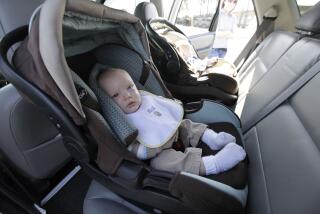Safety Agency May Press for Airliner Infant Seats
- Share via
SIOUX CITY, Iowa — Federal safety officials indicated Friday that they may step up the pressure on the government to require the use of infant seats on airline flights.
“We’re considering recommendations in that area,” National Transportation Safety Board member Joseph T. Nall said after presiding over four days of hearings on the July crash here of United Airlines Flight 232.
More than 10,000 infants fly in the United States every day, the airline industry estimates. Federal regulations allow children under 2 years old to fly free on the laps of adult passengers.
The potential consequences were dramatically illustrated in testimony released by the safety board. Three parents described how their children were torn from their grasp as Flight 232 began cartwheeling during its crash landing. The crash killed 112 people, including one infant.
“Suddenly, the world seemed to end. I saw for an instant my son’s body floating and flying at a very high speed down the right aisle towards the back of the plane,” recalled Sylvia Tsao, mother of Evan Tsao, who died of smoke inhalation one month before his second birthday. Sylvia Tsao, of Albuquerque, N.M., was uninjured.
She said she had followed the flight attendant’s instructions to place the baby on the cabin floor between her legs. “I remember being in the brace position, with my son’s head tucked between my knees, my left hand holding his ankle, my face pushing down on his head, my legs outside his legs,” Tsao said.
Another survivor, Gayle Notgrass of Pine Bluff, Wyo., told the safety board that her 23-month-old son, James, “flew up in the air, and I managed to grab ahold of him around the waist. He struck his head several times before the plane came to a stop, and several times I had to pull him back into my arms as he slid out of my grip.”
Eleven-month-old Sabrina Michaelson of Denver slipped from her mother’s grip and was plucked out of an overhead luggage bin after the crash, safety board documents show.
The best method of protecting infants during air turbulence or a rough landing is strapping them in an approved safety seat, buckled into a passenger seat, Federal Aviation Administration cabin-safety specialist Donnell Pollard said at Friday’s hearing.
The FAA, however, does not require use of safety seats, leaving it up to the parents to decide. If parents want to use safety seats, they must purchase a ticket for their infant.
The safety board has no power to mandate use of infant seats but can increase the pressure on the FAA through formal recommendations.
The Assn. of Flight Attendants and 56 House members have urged the FAA to require infant-safety seats.
More to Read
Sign up for Essential California
The most important California stories and recommendations in your inbox every morning.
You may occasionally receive promotional content from the Los Angeles Times.













